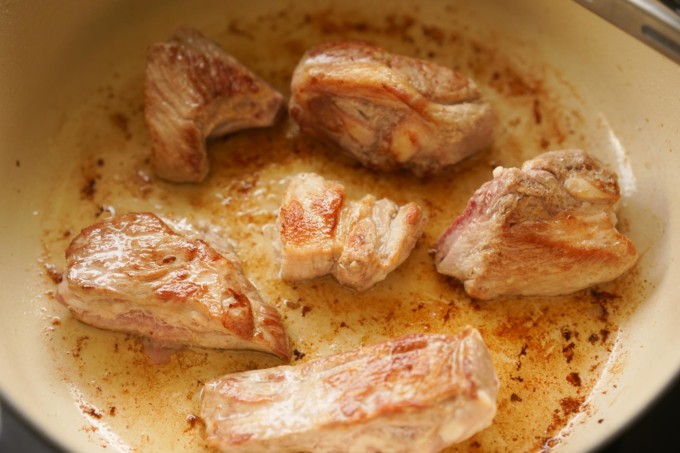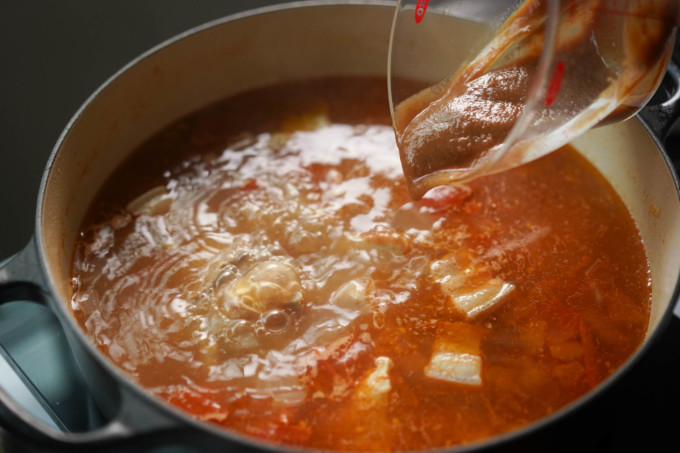Tangy and savory tamarind broth paired with buttery pork belly and spare ribs, acidic tomatoes, tender eggplant, earthy okra, and fresh string beans and daikon–this sinigang na baboy recipe will make you feel right at home with this famous comfort food.
Sinigang na baboy, or pork sinigang, is one of the most popular dishes in Filipino cuisine and its slightly sour flavor makes it stand out and very memorable. While many recipes online call for using the famous Mamacita’s or Knorr premade sinigang packets, I chose to make my own tamarind paste out of fresh fruit!

Background
Sinigang in Tagalog means “stewed dish” and is indigenous to the Philippines. Traditionally speaking, there are a variety of different ingredients added to the soup, like tomatoes, finger chiles, eggplants, kang kong (or water spinach), okra, string beans, and gabi (or taro). It’s great to mix and match vegetables based on your preference.
There are also many variations of sinigang, for example: sinigáng na isdâ (fish sinigang), sinigáng na hipon (shrimp sinigang), and more. Just like the dishes kare kare or pork adobo, sinigang is one of those quintessential Philippine dishes you find in Filipino restaurants and homes.

Funnily enough since my family is from Cebu, I actually didn’t grow up with sinigang on our dinner tables (we ended up eating more linat-ang baboy) and mostly fell in love with it as an adult visiting restaurants like Salo Salo.
Sour power: the tamarind
Tamarind is one of my favorite fruits and I have so many fond memories laying out in my aunt’s backyard in Cebu–right under the ginormous tamarind tree and eating as many fruits as I could. Since then, I’ve savored tamarind in as many different variations as I could get, from tamarind candy to sinigang.

After finding so many recipes that called for premade packets, I wanted to make my own tamarind paste to make a fresh version of this soup using fewer processed ingredients. I know what you’re thinking, why not just use premade tamarind paste, well I couldn’t find any locally, so I made my own.
While it’s an extra step in this process, it gave me more peace of mind knowing what was going into my stew AND I got extra tamarind to munch on while doing this recipe! I found boxed tamarind pods at my local Seafood City, but you can also find it at your local Asian grocery stores too. They usually come boxed or prepackaged.
Cooking tips

- Peel the tamarind pods before soaking them. Some recipes call for soaking the pods with the shells, but I prefer peeling them to remove any excess debris. It’s important to soak the flesh because it makes removing the seeds easier.
- Cook down the tamarind water and add lime for extra acidity. While tamarind has a sour flavor, I needed a concentrated tanginess so I added lime juice to really amp up the flavor. I feel like this really complements the tamarind really well. You can add more juice if you prefer too.
- Sear and braise the pork with tomatoes. Tomatoes also give this soup it’s sour flavor and acidity. You want to make sure to add most of the tomatoes at the beginning of the braise to squeeze out that acidic flavor into the broth. Many of these tomato pieces are obliterated after braising, so you also want to make sure you save at least one tomato piece to add later on.
- Use limes for more acidity and sourness. Since sourness levels are different for each person, you can adjust this recipe based on your personal preference. If you like EXTRA sour levels for your sinigang, I would recommend adding lime juice at the end to add more acidity and tanginess.
Who invented sinigang?
Sinigang is a traditional sour stew from the Philippines and is known for its tangy tamarind based broth.
What’s sinigang in English?
Sinigang in Tagalog means “stewed dish” in English.


Sinigang na Baboy (Filipino Pork Sinigang Soup w/ Vegetables)
Ingredients
Tamarind paste
- 3/4 c tamarind paste homemade or store bought
Sinigang
- 1 lb pork spare ribs
- 1 lb pork belly cut into ½ inch cubes
- 1 tbsp vegetable oil
- 1 medium yellow onion chopped
- 10 cloves garlic minced
- 5 small tomatoes (roma sized) quartered
- 8 c filtered water
- 2 2/3 tbsp salt and more as needed
- 1 tbsp fish sauce
Vegetables
- 1 small eggplant cut into ½" pieces
- 7 pieces okra cut into ½" pieces
- 4 inches daikon radish cut in ¼" slices, then cut into half rounds
- 7 string beans cut into 3" pieces
- 30 stems kang kong / water spinach / on choy
- ½ tsp pepper to taste
- lime juice optional for more sourness
- 1 finger chile pepper optional for spiciness
Equipment Used
Instructions
Tamarind paste
- Make your own tamarind paste using my instructions, or prepare store-bought tamarind paste, rehydrating if necessary.
Sinigang
- Pat the pork dry with a paper towel to improve browning during searing.
- In a large pot over medium heat, add the vegetable oil and begin to sear your meat in batches until all the sides have a nice golden brown crust. This should be about 2-5 minutes per batch. Try to not crowd the meat while searing. Transfer the meat onto a clean plate.
- In the same pot, add the onions and saute for about one minute or until the onions are slightly translucent. Add the garlic and saute for 30 seconds or until it’s fragrant.
- Add 2 cups of filtered water to deglaze the pot thoroughly. Gently scrape the golden brown parts from the searing meat at the bottom of the pan.
- Add the meat back to the pot with only 4 tomatoes (reserve the 5th one for later). Add 2 tablespoons of salt and stir to dissolve.
- Add 6 cups of water or enough so the meat is completely submerged. Bring the heat up to medium-high heat, once the liquid hits a boil let it boil for about 30 seconds.
- Drop the heat to a simmer (about medium-low heat) and simmer for about 45 minutes to 1 hour or until the meat is tender to your liking.
- Add the tamarind paste, pepper, and fish sauce to the pot and stir.
- Add the last tomato, eggplant, okra, string beans, and daikon radish into the pot and stir. Simmer for 5-8 minutes or until vegetables are tender, then add kang kong and cook for an additional one minute.
- Taste the soup and adjust with salt, pepper, or lime juice based on your preference. Serve immediately with a side of rice.








